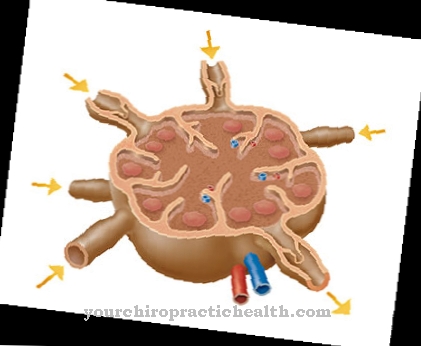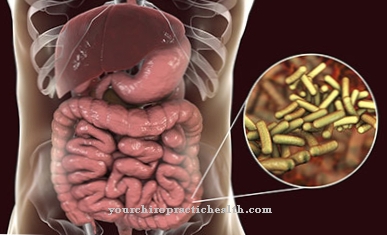Over half of all newborns develop a weaker or more pronounced yellowing of the skin shortly after birth, which in most cases is harmless. A morbid one Newborn jaundice but must be treated.
What is Newborn Jaundice?

© Kati Finell - stock.adobe.com
About 60 percent of all healthy newborns develop a noticeable yellowing of the skin in the first days of life: the Newborn jaundice.
It is caused by the accumulation of the yellow bile pigment bilirubin. In many cases the symptoms are harmless and go away on their own. Then it is called a physiological neonatal jaundice that does not require treatment.
However, if the symptoms remain for a certain period of time and the bilirubin levels in the blood exceed a certain level, the disease must be treated. If the baby is premature, the risk of newborn jaundice increases to 80 percent. In the technical language is also from a Neonatal icterus spoken.
causes
In most cases that is Newborn jaundice attributable to normal metabolic processes after birth: In the womb, the fetus is supplied with oxygen via many red blood cells. It is a specific variety, abbreviated to HbF.
After birth, the baby can breathe independently. So he needs fewer red blood cells and also a different type, HbA. The old blood cells have to be broken down, whereby the yellow bilirubin is formed. The not yet fully developed liver of the newborn cannot convert large amounts of bilirubin into a form that can be eliminated quickly enough, so that the skin turns yellow.
An increased breakdown of blood cells can occur, for example, if the blood groups of mother and child do not get along. Major bruises after childbirth and congenital anemia can also increase the chance of newborn jaundice. Premature birth, biliary tract disorders, certain metabolic disorders or some medications are other causes that can lead to an inadequate breakdown of bilirubin.
Children with what is known as Crigler-Naijar syndrome lack the enzyme that is responsible for breaking down bilirubin. A mostly physiological newborn jaundice can also be triggered by breastfeeding. The reasons for this are not yet fully understood.
Symptoms, ailments & signs
Newborn jaundice typically occurs within the first few days of life. It manifests itself first by the yellowing of the skin and by the yellowish-white discoloration of the white skin of the eyes. Most of the time, the sick infants appear slightly sickly and behave unusually. This can lead to increased activity or apathy, depending on the level of bilirubin levels and the individual course of the disease.
If the bilirubin values do not exceed a certain value, the newborn jaundice will subside by itself. No further complications or long-term effects are to be expected in this case. At higher values, however, bile pigments can be deposited in the brain. This can lead to physical and mental discomfort - so-called kernicterus occurs.
Sick infants are constantly tired and yawn frequently. Appetite and drinking behavior are reduced, which leads to deficiency symptoms and dehydration relatively quickly. In the further course, the muscle tension increases and the typical hollow back with a straight back is formed.
At the same time, the child becomes more and more restless, screams and cries or appears apathetic at times. Difficulty breathing and seizures also occur at this stage of the disease. In the long term, severe neonatal jaundice can lead to hearing and vision disorders, developmental disorders and malformations.
Diagnosis & course
A physiological one Newborn jaundice arises between the third and the sixth day after birth and regresses by the tenth or fourteenth day.
The yellowing of the skin and the white skin on the eyes is clearly visible. The doctor may check the bilirubin levels in the blood. The doctor receives initial information with the help of a multispectral device. This enables him to measure the proportion of colored light that can penetrate the skin. If there are indications of elevated levels, blood tests will be carried out to identify the cause. Bile and liver are also checked, for example with ultrasound images.
Diseased newborn jaundice can make the child sleepy and drink little. The reason for this is that the bilirubin can be deposited in certain areas of the brain. In the course of this so-called kernicterus, there may be increased muscle tension with the back depressed to the hollow back, shortness of breath, high-pitched screaming and seizures.Long-term consequences can include visual and hearing impairments, reduced mental development and movement disorders.
Complications
Newborn jaundice, or neonatal jaundice, occurs in 60 percent of newborns and is usually harmless. The disease is caused by the necessary remodeling or replacement of red blood cells after birth. The massive breakdown of erythrocytes of the type HbF causes a temporary inundation of the metabolism with the breakdown product bilirubin, which causes the typical yellow skin discoloration.
Normally, there are no further complications even if left untreated, and the yellow discoloration disappears completely after 10 to 14 days. However, if there is a pathological jaundice in the newborn, serious symptoms can develop if untreated, which can also cause irreversible damage. If the concentration of bilirubin in the blood is too high due to the insufficient ability to break it down, the substance can be deposited in the brain. A so-called kernic terus then sets in, which leads to increased muscle tone.
The affected newborns are usually sleepy and drink poorly. They tend to have a pronounced hollow back, high-pitched screaming and also seizures and shortness of breath. If left untreated, irreversible long-term damage such as visual and hearing impairments, movement anomalies and reduced mental development can occur. A targeted therapy is irradiation of the skin with blue light. This facilitates the conversion of bilirubin into its water-soluble form, which makes its breakdown and excretion much easier.
When should you go to the doctor?
In the case of an inpatient birth or a delivery accompanied by obstetricians, the nurses, midwives or doctors present take over the initial examinations of the newborn. If you discover irregularities or peculiarities in the general health of the baby, the next steps for adequate medical care are taken independently. The parents or relatives do not have to take action in these cases.
However, if the first signs of a health problem do not appear until a few days after the birth, the parents need to take action. In the event of a change in the appearance of the skin, yellowing of the skin or abnormal behavior in the offspring, a doctor should be consulted to clarify the symptoms. If the newborn refuses to feed, shows severe restlessness or screams incessantly, there is a health disorder that must be diagnosed and possibly treated. Although neonatal jaundice does not necessarily require medical care, a visit to a doctor is generally recommended.
In particular, other diseases should be ruled out through medical examinations in order not to endanger the life of the newborn. Tense muscles, indifference or apathy are further indications that should be investigated. If the infant shows an excessive need for sleep or a breathing disorder, a doctor should be informed of the observations. In the event of breathlessness, a doctor must be consulted immediately.
Treatment & Therapy
A morbid one Newborn jaundice is often treated with light or phototherapy. To do this, the skin is irradiated with blue light, which stimulates the bilirubin to convert into its water-soluble form.
This makes it easier for the body to break down the dye. As a side effect of light therapy, a harmless rash can develop that is usually not itchy. If the bilirubin concentration in the blood is greatly increased, blood exchange through an exchange transfusion is necessary.
Treatment is started fairly quickly in premature babies and infants who have jaundice onset particularly early. If the newborn jaundice lasts longer, it is likely a biliary tract disorder. Light therapy can provide a good remedy here.
prevention
There are very few ways of one Newborn jaundice to prevent. As far as possible, the baby should not be removed from the womb before the calculated date. Many parents also try to give their child as much light and sun as possible.
But the blazing midday sun is not suitable. The sun is most comfortable for sensitive baby skin in the early morning and late afternoon. Sun protection products should not be missing. Homeopathic medicines such as phosphorus C30 can also be useful.
Aftercare
Since therapy is not necessary in most cases of jaundice in newborns, no specific follow-up measures usually need to be taken. It usually heals in a short time without treatment. After two to three weeks at the latest, the child's yellowish skin color should have disappeared by itself. If this is not yet the case, additional measures may be necessary on the advice of the doctor.
However, there is usually no need for special follow-up examinations for jaundice. The treating pediatrician will observe the disease as part of the usual check-ups for newborns. In addition, the midwife will continue to check whether the jaundice has completely healed or whether action is required. If the symptoms persist for a long time, the pediatrician will usually order an up-to-date blood test for the child.
The bilirubin level is checked again. Depending on the findings, additional follow-up measures or renewed therapy may be necessary. However, going out into the light of day with the affected child is the most important follow-up measure for neonatal jaundice. This is particularly necessary if the newborn has already been treated with phototherapy in the hospital.
You can do that yourself
If it is already foreseeable in the puerperium that jaundice in the newborn is a dangerous form, treatment measures are taken in the hospital. However, there are a few methods that parents can use to help their jaundice resolve at home.
Parents should expose their child to sunlight as often as possible. The best way to do this is to lay the newborn naked in the light falling through the window. The rooms must be kept warm. Direct sunlight would be better, but there is a risk that the child could get an infection. The window glass lets the important "blue" light through anyway. At the same time, it helps to stimulate the newborn's bowel movements. Then the bilirubin already excreted by the liver, which leads to jaundice, is excreted directly and the risk of it getting back into the body is unnecessary.
The child should be breast-fed as often as possible to stimulate milk production. Whether the intestinal activity is actually stimulated can be seen in the frequent bowel movements of the child. However, you should refrain from feeding in bottle food or even complementary food, as it only irritates the newborn body. There is also no need to give water or tea. Breast milk alone is enough.






.jpg)




















